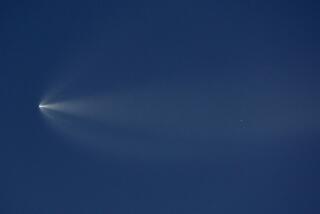SpaceX aces its ‘most difficult launch ever’ as it tries to impress the Air Force

SpaceX carried two dozen satellites into space early Tuesday aboard a Falcon Heavy rocket and spread them across the sky in a marathon mission that Chief Executive Elon Musk had described as the company’s “most difficult launch ever.”
It marked the first time the U.S. Air Force had launched satellites on a Falcon Heavy rocket, and also the first time the military had relied on previously flown SpaceX rockets — those that have been launched and returned to Earth.
Tuesday’s successful mission could bolster SpaceX’s case to win more Air Force contracts to launch sensitive military satellites.
The Air Force said after the launch that the mission enabled it to get insight into SpaceX’s booster recovery and refurbishment process, paving the way for future military-satellite launch missions to use previously flown boosters. In this mission, SpaceX landed the Falcon Heavy’s two side boosters again, but the rocket’s center core crashed into the ocean. SpaceX has not yet been able to recover a center core for its Falcon Heavy rocket.
The Falcon Heavy rocket lifted off from Kennedy Space Center in Florida at 2:30 a.m. Eastern time.
Almost nine minutes later, the Falcon Heavy’s two side boosters — which were used during an April mission — landed at Cape Canaveral Air Force Station.
The rocket’s center core ended up crashing into the ocean instead of landing on its intended target: a floating platform in the Atlantic Ocean.
The company said during a live-stream of the launch that the center core’s landing was the most difficult landing it had ever attempted. During this mission, the booster needed to propel the rocket’s second stage higher and faster than on previous flights, meaning the booster came back to Earth hotter and moving faster than usual, SpaceX said.
Musk tweeted early Tuesday that a boat outfitted with a large net caught the rocket’s fairing — a clamshell-like covering that protects the satellites as the rocket hurtles to space.
The last of the 24 satellites was deployed about 3 ½ hours after liftoff.
A new batch of Air Force launch contracts is up for grabs, and Hawthorne-based SpaceX is competing against longtime rival United Launch Alliance — a joint venture of Boeing Co. and Lockheed Martin Corp. — as well as Northrop Grumman Corp. and Jeff Bezos’ Blue Origin, which have never launched military satellites.
In October, ULA, Northrop and Blue Origin were awarded a combined total of about $2 billion in funding to develop new rockets to launch military satellites. SpaceX did not receive one of those development awards and formally challenged the Air Force’s decision last month.
SpaceX is still eligible to participate in a second phase of the competition, which will award launch contracts to two competitors.
Tuesday’s launch, known as Space Test Program-2, was designed to test the capabilities of SpaceX’s Falcon Heavy rocket, which has launched twice before. The rocket deployed satellites in three different orbits. The mission also involved four second-stage engine burns to take the satellites to their destinations.
“This just solidifies SpaceX’s position within the market, and [especially] with the U.S. military launch market,” said Marco Cáceres, senior space analyst for market research firm Teal Group.







